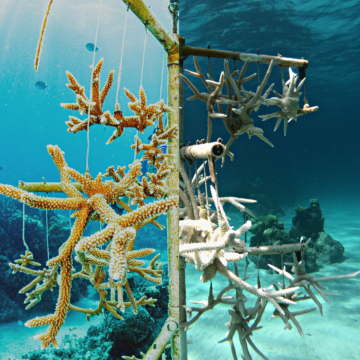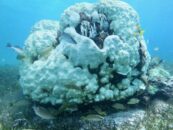
NASSAU, BAHAMAS — The Bahamas Reef Environment Educational Foundation (BREEF) is sounding the alarm over record-breaking temperatures ocean temperatures in The Bahamas that have already had "serious repercussions" on the nation's dense concentration of coral reefs.
Divers, tour operators, and fishers throughout the Bahamian archipelago have observed large areas of white corals, noticing that the usual vibrant yellow, green and orange hues of healthy coral reefs have been replaced by bright white bleached coral. Scientists have been documenting the progression of coral bleaching around The Bahamas and the world.
Ocean Atlas, the world's largest underwater sculpture and now an iconic underwater feature visited by Bahamians and visitors worldwide every year, also feels the impacts of the elevated water temperatures and consequent stress on corals.
 Ocean Atlas underwater sculpture exhibiting signs of coral bleaching
Ocean Atlas underwater sculpture exhibiting signs of coral bleaching
A statement from BREEF claimed that the Foundation created the Coral Reef Sculpture Garden in the waters off Western New Providence in 2014 to draw attention to the threats faced by Bahamian coral reefs and inspire action for conservation.
Since installing Ocean Atlas and the other sculptures, they have become encrusted in live corals and are now a habitat for a great diversity of species of marine life.
The sculpture garden is also BREEF's underwater classroom, and it is a well-loved site where thousands of Bahamian children have had a chance to learn about marine conservation and often take part in their first-ever snorkeling experience.
"It's shocking to see the severe coral bleaching taking place on reefs around the Bahamian archipelago. Many people have a personal connection to Ocean Atlas. Seeing this dramatic bleaching occurring at such an iconic site resonates with people and will hopefully inspire much-needed action." stated BREEF Executive Director Casuarina McKinney-Lambert.
Coral bleaching occurs when corals expel the symbiotic algae living in their tissues. These algae, known as zooxanthellae, provide corals with up to 90% of their nutrition through photosynthesis, and they are also responsible for giving the corals their color.
When coral is stressed by elevated water temperature, the algae is expelled from the coral tissue, leaving the coral colorless and starving. The coral will die if the stress and subsequent bleaching persist for too long. If the stress is removed, for example, by water temperatures dropping, there is a chance for it to regain its zooxanthellae and its color and recover.
 Fish swim around coral bleached from heat stress in August 2023.
Fish swim around coral bleached from heat stress in August 2023.
There has already been evidence of some coral mortality at the BREEF Coral Reef Sculpture Garden, including some of the corals that BREEF is growing in the coral nursery and some of the corals that have been outplanted to adjacent reefs. Some of the corals have bleached and died. Others, particularly those where the coral fragments were sourced from shallower sites, are still healthy.
"What happens in the oceans does not stay in the oceans, it affects the whole planet," NASA Chief of Ocean Ecology Laboratory, Dr Carlos Del Castillo, said at a press conference with NASA and NOAA (National Oceanic and Atmospheric Administration) experts in August. Castillo noted that the oceans are experiencing 90% of global warming as they absorb the heat.
"In Florida recently, with measurements approaching 100 degrees, exceeding 100 degrees in some areas are bad for organisms, not only are we seeing an increase in the frequency of coral bleaching, but we are also seeing coral, fish, and seagrasses die off," he said.
The Bahamas is home to 35% of all coral reefs in the wider Caribbean region. Despite covering less than 1% of the ocean floor, coral reefs support over 25% of all marine life.
"To add insult to injury, all this CO2 that we are putting in the atmosphere also dissolves in the water and acidifies it," he continued, "The ocean waters are about 25% more acidic than at the beginning of the industrial period, and this is not good for corals."
Although The Bahamas produces only a tiny amount of the greenhouse gases that are changing the climate, the country feels a disproportionate amount of the negative impacts of climate change, from climate-fueled hurricanes to catastrophic bleaching of reefs.
Still, BREEF Executive Director Casuarina McKinney-Lambert sees this crisis as an opportunity.
"The Bahamas has an opportunity to take the lead in the shift away from fossil fuels and encourage other countries to do the same," she said.
Click here to read more on the Eye Witness News website





